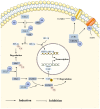Targeting neddylation as a novel approach to lung cancer treatment (Review)
- PMID: 37083098
- PMCID: PMC10147314
- DOI: 10.3892/ijo.2023.5513
Targeting neddylation as a novel approach to lung cancer treatment (Review)
Abstract
As a protein that resembles ubiquitin, neural precursor cell expressed developmentally downregulated 8 (NEDD8) takes part in neddylation, which modifies substrates in a manner similar to ubiquitination and alters the activity of target proteins. Neddylation may affect the activity of multiple signaling pathways, have a regulatory role in tumor formation, progression and metastasis, and influence the prognosis of cancer treatment. The present review summarizes the regulatory roles of NEDD8 in the MDM2‑p53, NF‑κB, PI3K/AKT/mTOR, hypoxia‑inducible factor, Hippo and receptor tyrosine kinase signaling pathways, as well as in the development and progression of lung cancer.
Keywords: MLN4924; NEDD8; lung cancer; neddylation; signaling pathway; treatment.
Conflict of interest statement
The authors declare that they have no competing interests.
Figures





Similar articles
-
Validation of NEDD8-conjugating enzyme UBC12 as a new therapeutic target in lung cancer.EBioMedicine. 2019 Jul;45:81-91. doi: 10.1016/j.ebiom.2019.06.005. Epub 2019 Jun 14. EBioMedicine. 2019. PMID: 31208947 Free PMC article.
-
Advancements in colorectal cancer research: Unveiling the cellular and molecular mechanisms of neddylation (Review).Int J Oncol. 2024 Apr;64(4):39. doi: 10.3892/ijo.2024.5627. Epub 2024 Feb 23. Int J Oncol. 2024. PMID: 38391033 Free PMC article. Review.
-
Overactivated neddylation pathway as a therapeutic target in lung cancer.J Natl Cancer Inst. 2014 May 22;106(6):dju083. doi: 10.1093/jnci/dju083. Print 2014 Jun. J Natl Cancer Inst. 2014. PMID: 24853380
-
Effective targeting of the ubiquitin-like modifier NEDD8 for lung adenocarcinoma treatment.Cell Biol Toxicol. 2020 Aug;36(4):349-364. doi: 10.1007/s10565-019-09503-6. Epub 2020 Jan 6. Cell Biol Toxicol. 2020. PMID: 31907687
-
Diverse and pivotal roles of neddylation in metabolism and immunity.FEBS J. 2021 Jul;288(13):3884-3912. doi: 10.1111/febs.15584. Epub 2020 Oct 20. FEBS J. 2021. PMID: 33025631 Review.
Cited by
-
Neddylation modification stabilizes LC3B by antagonizing its ubiquitin-mediated degradation and promoting autophagy in skin.Proc Natl Acad Sci U S A. 2025 Apr 15;122(15):e2411429122. doi: 10.1073/pnas.2411429122. Epub 2025 Apr 10. Proc Natl Acad Sci U S A. 2025. PMID: 40208944 Free PMC article.
-
The impact of neddylation on prognosis in the immune microenvironment of neuroblastoma: a single-cell transcriptomic analysis.Immunol Res. 2025 Jul 17;73(1):107. doi: 10.1007/s12026-025-09662-1. Immunol Res. 2025. PMID: 40676385
References
-
- Howington JA, Blum MG, Chang AC, Balekian AA, Murthy SC. Treatment of stage I and II non-small cell lung cancer: Diagnosis and management of lung cancer, 3rd ed: American College of Chest Physicians evidence-based clinical practice guidelines. Chest. 2013;143(5 Suppl):e278S–e313S. doi: 10.1378/chest.12-2359. - DOI - PubMed
Publication types
MeSH terms
Substances
LinkOut - more resources
Full Text Sources
Medical
Research Materials
Miscellaneous
